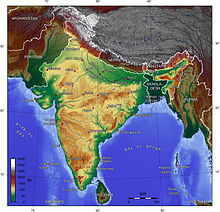This article needs additional citations for verification. (November 2015) |

The Indian Himalayan Region (abbreviated to IHR) is the section of the Himalayas within the Republic of India, spanning thirteen Indian states and union territories, namely Ladakh,[1] Jammu and Kashmir,[2][3][4] Himachal Pradesh, Uttarakhand, Sikkim, West Bengal, Manipur, Meghalaya, Mizoram, Nagaland, Tripura, Assam, and Arunachal Pradesh.[5][6][7][8] The region is responsible for providing water to a large part of the Indian subcontinent and contains various flora and fauna.[9]
Physiographically, the Himalayas start from the foothills of south (Sivaliks) and extend up to the Tibetan plateau of the north (Trans-Himalaya). Three major geographical entities, the Himadri (greater Himalaya), Himachal (lesser Himalaya) and the Sivaliks (outer Himalaya), extend almost uninterrupted throughout its length and are separated by major geological fault lines. Huge but older waterways like the Indus, Sutlej, Kali, Kosi and Brahmaputra cut steep gorges through the main Himalayan range to escape into the Great Plains, establishing their antecedence.
The northernmost range of mountains are the trans-Himalayan Karakoram Mountains that continue from India into Pakistan and China. To the south of the Karakoram Range lie the Zanskar and Ladakh ranges.
Some of the highest mountains on Earth are also found in the region. Many perennial, glacier-fed rivers flow from the Himalayas.
- ^ [1]
- ^ [2]
- ^ [3]
- ^ [4]
- ^ "SUSTAINABLE DEVELOPMENT IN THE INDIAN HIMALAYAN REGION". NITI Aayog. Retrieved 13 June 2023.
The Indian Himalayan Region is spread across 13 Indian States/Union Territories (namely Jammu and Kashmir, Ladakh, Uttarakhand, Himachal Pradesh, Arunachal Pradesh, Manipur, Meghalaya, Mizoram, Nagaland, Sikkim, Tripura, Assam and West Bengal), stretching across 2500 km.
- ^ O'Neill, Alexander; et al. (25 February 2020). "Establishing Ecological Baselines Around a Temperate Himalayan Peatland". Wetlands Ecology & Management. 28 (2): 375–388. Bibcode:2020WetEM..28..375O. doi:10.1007/s11273-020-09710-7. S2CID 211081106.
- ^ "Indian Himalayan Region - ENVIS Centre on Himalayan Ecology, GBPIHED".
- ^ "Indian Himalayan Region (IHR)".
- ^ Sustainable development of the Indian Himalayan region : Linking ecological and economic concerns